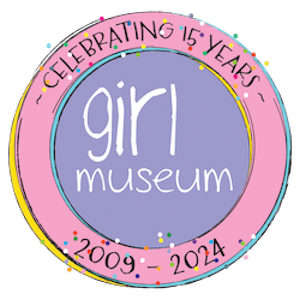Girl Museum
Founded in 2009, the Girl Museum is the first museum dedicated to researching and sharing the history of girlhood worldwide. The fully online museum is run by a team of historians, curators, and educators from around the world to provide opensource access to exhibits, educational guides, and peer-reviewed publications for K-12 educators and the general public. The curatorial team emphasizes the need to study the history and culture of girlhood—that they define as those under the age of twenty-one—from a variety of perspectives, as stories about girlhood are often excluded from traditional historical narratives and course curricula. Incorporating the study of girlhood and childhood in K-12 classrooms can help students connect with global history on a more personal level and highlight how girls and children throughout history have actively participated in shaping our present.
Each exhibition is comprised of primary sources—including paintings, photographs, objects, and/or letters—a curatorial essay, and an educational guide to be used alongside the exhibit. Each lesson plan featured in the educational guides follows United States’ and/or United Kingdom’s corresponding benchmarks for K-12 Education Standards. Ranging from art history, to social and cultural histories, to literature studies, the Girl Museum’s educational guides offer multidisciplinary approaches to studying global girlhood in K-12 classrooms. A few exhibits include: Hina Matsuri, which explores the history surrounding Japan’s celebration of Girls’ Day, celebrated on March 3rd and established in Japan’s Edo Period (17th-19th centuries); Impressionist Girls, which uses social and art history to explore girlhood in late-19th century France; and Home & Away: Girls of the British Empire, which is outlined in more detail below.
The Home & Away: Girls of the British Empire exhibit explores girlhood in Great Britain and its colonies through historical photographs and postcards. Its educational guide. Using race, class, geographic location, and temporal eras as analytic categories to compare girls’ lives throughout the British Empire, the exhibit explains “how girls participated in and were viewed within” the Empire. The activities featured in the educational guide correspond to KS1 and KS2 UK standards—or about first through fourth grade in the US—making them good tools for primary school teachers seeking to incorporate global history themes into courses. A few of the activities include: 1) students select a postcard from the exhibit and write home explaining how their life is like under British rule in that area; 2) students write diary entries from the perspectives of girls living in a British colony; 3) students research flags of former colonial holdings and compare with classmates’ findings; 4) students research and write an essay on the impact of Queen Victoria’s rule on girls around the Empire. This last activity can be extended for high school students by having students complete more in-depth research into girls in specific colonial holdings and connect those stories back to the history of the British Empire. This guide helps educators place the history of girlhood within a broader history of the British Empire, and can be considered alongside World History Common’s Teaching Module, “Exploring Empire through the Lens of Childhood and Gender.”
In addition to the educational guides accompanying exhibitions, one of the Girl Museum’s ongoing mapping projects features a teaching guide and provides an opportunity for (particularly middle and high school) students to contribute to the map. The Sites of Girlhood mapping project is a crowd-sourced, peer-reviewed project that allows girls from around the world to contribute by identifying, interpreting, and sharing the stories of girls from all over the globe. The corresponding educational guide offers three lesson plans, ranging from first and second grades to nineth and tenth grades. A few activities include: 1) a scavenger hunt of the Sites of Girlhood map; 2) a mapping activity for students to map their own communities; 3) a documentary-making guide for students to research and present the stories of the girls featured on the map.
Though the exhibits and educational guides through the Girl Museum are great at placing girls into history, the volunteer-nature of the site makes it so there are not quite as many exhibits as a larger institution may have; there are about forty exhibits as of this writing, and the themes are not cohesive. (These exhibits are not static, however; the team publishes new materials on occasion.) Further, to use the exhibits as classroom resources, educators will need to carefully consider where these lessons can fit in the existing curricula. The learning objectives and standards help as a guide, but the educational guides do not explicitly recommend which courses may be a good fit for the materials. This could be helpful for allowing room for creativity, or confusing if one is unsure where materials may fit best. Using exhibition introductions and primary sources to help identify corresponding time periods, regions, and themes can help fit the lesson plans into various curricula—including world history, the history of a specific region or country, English and literature, geography, or art history.
Overall, the Girl Museum’s exhibits and educational guides offer tangible, multidisciplinary ways for educators to incorporate the history of girlhood into world history curricula. Its educational materials for both primary and secondary classrooms are ideal for students of multiple ages to engage with the material, and its crowd- and opensource nature allow for students to participate in the history-making process themselves. The exhibit topics cover a wide range of subjects and make important interventions by placing girlhood more squarely into the teaching of history, literature, culture, and arts on a global scale.
